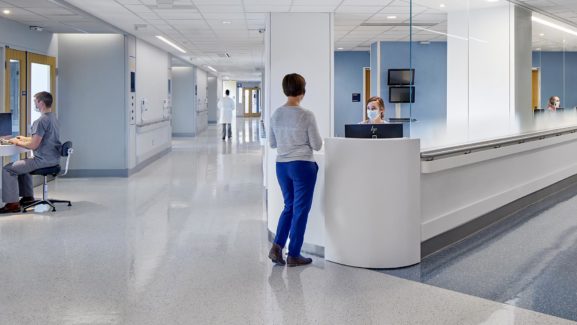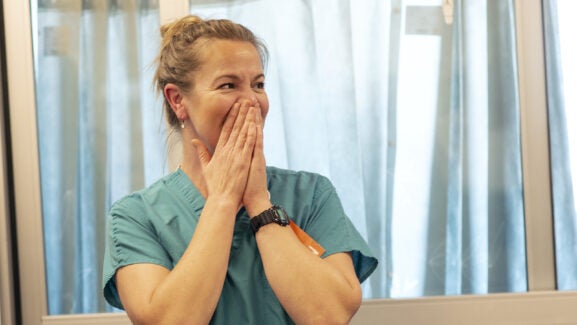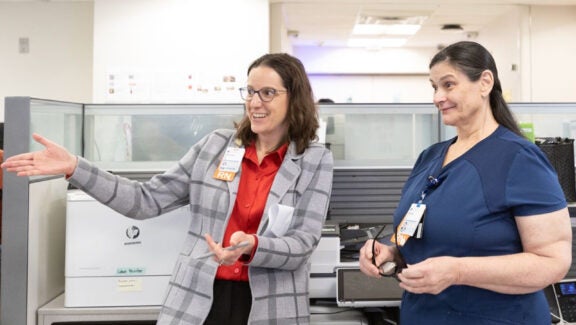
Collaboration Is Key When Preventing Falls
Patient falls are an unfortunate reality in any hospital setting, with more than 30% of inpatient falls resulting in patient harm. Serious falls can result in fractures or intracranial bleeds, and less severe falls cause pain, fear, and anxiety.
In recognition of Falls Prevention Awareness Day on Sept. 22, the Falls Coalition shared their important work, their success in reducing falls at UVA, and how everyone at UVA Health can all do their part to keep our patients and colleagues safe. Led by Michelle Longley, the coalition has been working together for over two years.
Fall Coalition Members:
- Michelle Longley, MSN, RN, NP-C, AGCNS-BC, Advanced Practice Provider, Fall Prevention Metric Lead
- Ellen Smith, BSN, RN, LSSBB, Quality and Performance Improvement (QPI) Coach
- James Carnes, MSN, MBA, RN, Administrator, Radiology & Medical Imaging
- Brett Mitchell, PT, DPT, Physical Therapist
- Melissa Creighton, OTR/L, CLT, Occupational Therapist
- Rachele Olivier, MSN, RN, CMSRN, Inpatient Oncology & Stem Cell Transplant Assistant Nurse Manager
- Jennifer T. Hall, MSN, RN, CNL, Interim Director, Nursing Professional Practice
- Mary Jane Willis, BSN, RN, CPPS, Patient Safety Officer (PSO)
- Tausha Grim, MSN, RN, Clinical Program Coordinator – Nursing Initiatives
Why is preventing falls important at UVA Health?
Willis: If we can prevent falls, we are preventing injury or lessening the severity of an injury associated with falling. Falls impact our patients (often resulting in lengthened stay or additional treatment/procedure), our team members (who may suffer personal injury when attempting rescue during falls, and emotional injury when unable to prevent a fall), and our patients' families (who may need preparation to provide additional at-home support).
As part of my PSO role, it's essential to contribute to coalition work to improve the quality of care delivered every day at UVA Health.
What is the coalition’s approach to fall prevention?
Longley: Often, falls are focused on nursing practice, but our coalition at UVA Health is uniquely interprofessional. We have physical therapists, occupational therapists, and RNs all using the same tool to screen patients, which has deeply enriched our identification of high risk.
With coaching from Ellen Smith of QPI, the Falls Coalition has focused on priorities based on fall event trends and clinician feedback. These priorities include efforts to ensure clinicians can accurately identify patients' fall risk through interprofessional fall risk screening and leveraging Epic to indicate fall risk levels.
We also streamlined the fall prevention standard work into four primary buckets:
- Communication of risk and mobility needs
- Using mobility alarms
- Remaining with arm's reach with direct visualization during ambulation and toileting
- Highlighting specialized interventions for cognitively impaired patients such as telesitting, padded floor mats, and prioritizing these patients to be placed closer to nurse stations when possible.
Two monumental efforts for our fall prevention standard work included establishing an escalation pathway to ensure patients and families cannot refuse mobility alarms (available here) and partnering with the Staffing Resource Office to launch the telesitting program.
Has the coalition been able to reduce falls?
Creighton: Yes, we are thrilled to be seeing a 40% reduction in falls in fiscal year 21, with only one fall with injury in April.
As a coalition, we are passionate about discovering what works and what doesn't work regarding fall prevention for our patients and colleagues. We couldn't do it without the collaboration and dedication of all the hardworking team members who put safety first!
Carnes: Radiology & Medical Imaging had previously been experiencing as many as four inpatient falls with injury each year, some of which also resulted in a team member injury. While that may not seem like a high number, the seriousness of those patient falls was typically severe — resulting in fractures and other serious injuries.
Developing and implementing falls prevention standard work across the various areas of our department — in collaboration with many of our clinical colleagues, such as the Emergency Department and Neurosurgery — has enabled and empowered the imaging team members to provide imaging to patients in a much safer manner. We have had zero inpatient falls with injury during the past 18 months. That outcome feels fantastic!
What factors put a patient at risk for falling?
Creighton: There isn't always a sole identifying factor for fall risk, though there can be. That's why taking the time to do a falls risk assessment on each patient is essential.
For example, if a patient is admitted for active seizure activity, that alone could place the patient at a higher risk of falling during this admission. On the other hand, a patient who is mildly unsteady or just had a surgical amputation to their leg would not automatically be considered a high fall risk during this admission. But combine that with multiple lines, high-risk medications, and urinary urgency/frequency, the patient would be placed at a much higher risk.
How can we all continue to help prevent inpatient falls at UVA Health?
Longley: In our adult inpatient setting, screening patients for fall risk and implementing our interprofessional and multifactorial fall prevention standard work is very effective at reducing the possibility of an inpatient fall.
Olivier: Our coalition has found the following strategies to be effective:
- Proper education and hands-on training for healthcare clinicians in terms of fall prevention standard work and bed/chair alarm activation
- Effective communication with members of the healthcare team, articulating fall prevention needs of the patient
- Consistent bedside rounding to ensure fall prevention standard work is in place for high fall-risk patients.
- Timely documentation of the Johns Hopkins Fall Risk Assessment Tool (JHFRAT) for new admissions and transfers and an indication of a patient status change
- Partnership with unit leadership to round on high fall risk patients to ensure fall preventions are in place
- Partnership with LIPs and front-line clinicians to ensure consistent messaging and re-education to patients/care partners
What advice do you give patients and their families for preventing falls at home?
Mitchell: It’s important to educate patients during discharge on how to stay safe once they’re home from the hospital. Our advice to patients is always the following:
- Be very self-aware in your recovery; understand your limitations
- Engage in activity modification
- Request additional support as needed
- Once a safe activity level is established, initiate an exercise/walking program that enables your body to ease back into your routine
What lessons will you carry forward as you continue this important work?
Mitchell: Establishing standard work for fall prevention in a large institution is just the beginning. To ensure the standard work is followed requires ongoing maintenance: constant replacement of physical resources, continuous training and retraining of staff, modifications to the existing guidelines, and specialized efforts with unique patient populations.
Overall, I see teams coming together not only to prevent falls but also to prevent any type of injury to their patients and colleagues. Just this week on Sept. 20, we reported no new hospital-acquired pressure injuries (HAPIs) in our adult inpatient units for over a month. That is a major accomplishment and one that should make us all proud to work at UVA Health.
Photo, left to right: Ellen Smith, James Carnes, Tausha Grim, Michelle Longley, Rachele Olivier, and Melissa Creighton. Not pictured: Brett Mitchell, Jennifer T. Hall, and Mary Jane Willis.
Latest News



